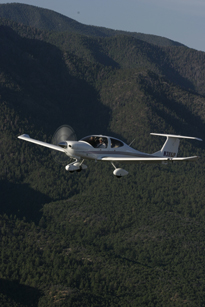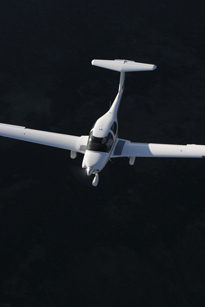 By Jim Van Namee, CFII By Jim Van Namee, CFII
Strapping on the Diamond Star’s four-seated DA40 is a fun thing to do here in the high altitudes and mountains of the Southwest. By way of the great visibility with a bubble canopy, you know you are going to see sights the way God wants you to – with low wings. Having the stick in the center of your office, and the throttle on the right (right? – Oh no, now I’m a cross controlled pilot) you get the feel of “the good old days” before the word “yoke” came into your lexicon. The stick is well designed having the electric trim, mike button and autopilot trim disconnect well placed for easy use.
This particular DA 40 (N960TA) has a Garmin 1000 glass cockpit installed and is a joy to behold and operate. Once you apply internal electrical power the glass comes to life without your intervention and the airplane becomes alive and ready take you anywhere you want to program it to go. Yes, this is an autopilot airplane. You can program a flight, activate it on climb out, select the appropriate arrival and approach at your destination, and deselect the autopilot at minimums. Other than that, you monitor the system and adjust the throttle as needed. The pilot display has an electronic HSI, Vr, Vx, and Vy bugs on the tape airspeed indicator. The tape altitude indicator has an altitude reference bug. You can set it for pattern altitude or Minimum Descent Altitudes – a great feature. There are other attributes too numerous to describe.
 The left glass presents the pilot with electronic flight instrument displays and the right side provides topographical, navigational and systems data. The Terrain Avoidance function is a great feature for flying in this mountainous environment, especially at night. If you want to relive your childhood (those days when you were a fighter pilot and the throttle was in the correct hand – the left one) then fly in the right seat, press the red button on the intercom panel and you get the pilot display on the right glass. The left glass presents the pilot with electronic flight instrument displays and the right side provides topographical, navigational and systems data. The Terrain Avoidance function is a great feature for flying in this mountainous environment, especially at night. If you want to relive your childhood (those days when you were a fighter pilot and the throttle was in the correct hand – the left one) then fly in the right seat, press the red button on the intercom panel and you get the pilot display on the right glass.
While starting the plane, the electronic Attitude Heading and Reference System aligns the G1000 GPS with available satellites. By the time you are ready to taxi, the system is up and running. If you have any experience with Garmin products you should have no trouble operating the G1000. From a button-pushing point of view, it’s somewhat like a Garmin 430 on serious steroids.
Utilize brakes for taxiing, as the castering nose wheel is not connected to the rudder pedals. The wings are a few feet wider than most general aviation airplanes so pay attention to those things that might cause a “dink” (“ding” is for metal airplanes – this one’s plastic). For the most part, the plane flies like any other plane; pull back on the stick and the houses get smaller; continue to pull back on the stick and the same houses eventually get bigger. The first really noticeable change however is the sensitivity of the stick. It doesn’t take much to cause the elevator to move. Your first take-offs will have you fine-tuning the nose attitude until you get used to how much back pressure to utilize. Once airborne, and trimmed, drop your hand down to the bottom of the stick’s handle and you be flying it like a pro.
After comfortably airborne, reduce propeller RPM to 2400 turns and expect a noticeable drop in noise. At Taos Regional Airport, 7091’ MSL and 86 degrees outside air temperature, the POH climb rate with a Max Gross Weight of 2535 lbs. is a bearable 1.5 meters per second (hey, that’s what the Austrian developed manual defines as climb rate – I’m not trying to be difficult here). This equates to 300 FPM. In Albuquerque at 54 degrees you get approximately 600 FPM. Sea level climb is close to 1000 FPM. In real life, with full fuel and two people we usually see a comfortable 500-600 FPM in warm temperatures departing Taos Regional.
 The DA40 has an easy feel when hand flying. Elevator authority is good with easy backpressure to maintain level flight in turns. It cruises at a respectable 135-140 knots at 10,000’ MSL at summer temperatures while burning an economically 8.5 GPH of fuel. The DA40 has an easy feel when hand flying. Elevator authority is good with easy backpressure to maintain level flight in turns. It cruises at a respectable 135-140 knots at 10,000’ MSL at summer temperatures while burning an economically 8.5 GPH of fuel.
Landings are rather normal. One delivery pilot indicated that the plane should be flown in a wider pattern than normal. However, I don’t agree with that. I fly it using the same ground track as a Cessna 172/182 or a Piper Cherokee and it does fine. The manual indicates it has a glide ratio of 1.4 miles/1000’ of altitude loss, which is less than a Cessna 172 or 182 (1.5 miles/1000’) so that advice doesn’t make sense to me.
The airplane exhibits great manners and is easy to fly. As an IFR platform, it has few contemporaries. It handles quite nicely in a crosswind landing. Cabin room is very comfortable. The cockpit has large air vents that can be a bit noisy when full open. Since there are no visors, it is a good investment to buy Sun Shades and place them accordingly while flying.
Back on the ramp the DA40 exudes sex appeal. It’s hard for 1950 era designs to compete with it. And, as other pilots pass by, with the G1000 panel, you’ll get a lot of interesting comments and questions.
For more information on the Diamond Star DA40 contact US Aero at 877-Fly-Aero or at www.USAero.aero.
Author’s bio:
Jim Van Namee, CFII and owner of Silver Eagle Aviation, LLC, operates at Taos Regional Airport (KSKX) in Taos, NM. He retired as a Naval Aviator with over 6000 flight hours and bunches of carrier landings. He is the New Mexico Pilots Association Director of Mountain Flying Instruction and a Designated FAA Aviation Safety Counselor. He can be reached at silvereagleav@taosnet.com or 505-377-6786. |